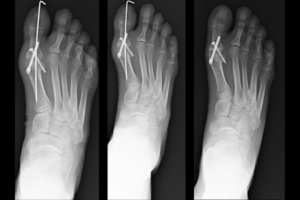Photobiomodulation often referred to as PBM, is a series of photochemical reactions using non-ionizing forms of light such as lasers and LEDs and is a nonthermal process.[i] PBM describes the biological process that occurs at the systematic and local level when non-ionized light forms are used in a therapeutic setting.[ii]
PBM vs. PBMT
PBM is the biological and photochemical response to non-ionizing light, whereas photobiomodulation therapy (PBMT) refers to the application of the PBM processes for therapeutic purposes. PBMT is a non-pharmacological therapy, using a series of photochemical reactions to ease pain and inflammation while also promoting healing.[iii] PBMT is used to treat acute or chronic pain and has been shown to reduce pain and inflammation associated with a range of musculoskeletal conditions.[iv] Multiple PBMT treatments are often required for optimal pain relief.[v] In short, PBMT is the overarching term used to describe the use of non-ionizing forms of light for a therapeutic application.[vi]
PBMT vs. Laser Therapy
What is the difference between photobiomodulation and laser therapy? In short, there isn’t one! Over time photobiomodulation has come to replace the term low level laser therapy (LLLT). One of the reasons for the switch to the term photobiomodulation is a lack of clarity as to what the “low” in low level laser therapy is.[i] As therapeutic technologies have evolved, therapy lasers have become more powerful and efficient growing out of the “low level” label.
The phrase “photobiomodulation therapy” is a representation of the current technologies and therapies available. It encompasses various types of non-ionizing light sources, including basic LEDs and lasers as well as more advanced technologies such as the MLS® Therapy Laser that delivers controlled laser energy by synchronizing two therapeutic wavelengths.[ii]
References:
[i] Anders, Juanita J. “Photobiomodulation.” ASLMS. Last modified June 27, 2016. https://www.aslms.org/for-the-public/treatments-using-lasers-and-energy-based-devices/photobiomodulation.
[ii] Vetrici, Mariana A., Soheila Mokmelia, Andrew R. Bohm, Monica Monici, and Scott A. Sigman. “Evaluation of Adjunctive Photobiomodulation (PBMT) for COVID-19 Pneumonia via Clinical Status and Pulmonary Severity Indices in a Preliminary Trial.” Cutting Edge Laser Technologies. https://celasers.com/knowledge-center/evaluation-of-adjunctive-photobiomodulation-pbmt-for-%20covid-19-pneumonia-via-clinical-status-and-pulmonary-severity-indices-in-a-preliminary-trial
[iii] “The Purpose of NAALT.” North American Association for Photobiomodulation Therapy. https://www.naalt.org/.
[iv] Anders, Juanita J. “Photobiomodulation.” ASLMS. Last modified June 27, 2016. https://www.aslms.org/for-the-public/treatments-using-lasers-and-energy-based-devices/photobiomodulation. ; Oliveira, Marcelo Douglas Johnson, Timothy Demchak, Shaiane Tomazoni, and Ernesto Leal, Jr. “Low-intensity LASER and LED (photobiomodulation therapy) for pain control of the most common musculoskeletal conditions.” National Library of Medicine. Last modified December 16, 2021. https://pubmed.ncbi.nlm.nih.gov/34913330/.
[v] Vetrici, Mariana A., Soheila Mokmelia, Andrew R. Bohm, Monica Monici, and Scott A. Sigman. “Evaluation of Adjunctive Photobiomodulation (PBMT).
[vi] “Evaluation of Adjunctive Photobiomodulation (PBMT).
[vii] Hamblin, Michael R. “Photobiomodulation or low-level laser therapy.” National Library of Medicine. Last modified December 2016. https://www.ncbi.nlm.nih.gov/pmc/articles/PMC5215795/.
[viii] “The Science Behind MLS Laser Therapy.” Cutting Edge Laser Technologies. https://celasers.com/laser-therapy-science ; “The Purpose of NAALT.”



